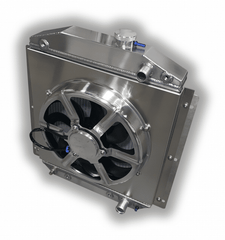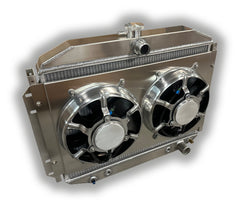I was chatting with a customer a few days ago about how to plumb up his trans cooler. His application is a ’68 C10 with a 376 LS3 and 4L80e that spends the majority of it’s life as a cruiser. This customer showed me some diagrams he dug up on the internet.. and I was taken aback by the proliferation of ‘bro science on the internet.
Now, I respect the intent of ‘bro science. But I’m also a mechanical engineer whose been working in the radiator business since I was an intern at Modine in college 25 years ago. There are many things I don’t know, but I do know a few things about cooling.
In the post, I’m going to cover the correct way to plumb up your external trans cooler in conjunction with your internal transcooler. So let’s right this wrong.
The Wrong Way
If you spend a few minutes on Google looking up ‘how to plumb an external trans cooler’, you’ll find some version of this diagram straight from the PhD program at ‘Bro Science University:


The way 99% of the ‘bro science inspired diagrams recommend plumbing the trans cooler is like this:
- Hot fluid out of the transmission and into the submerged cooler in the radiator.
- Less-hot fluid out of the radiator and into the external trans cooler.
- Cooled fluid out of the external cooler and back into the radiator.
Let’s break each of these steps down and look at what happens in each step.
Step 1: We have hot transmission fluid coming out of the transmission and into the submerged cooler in the radiator. The submerged trans cooler in a radiator is typically on the cold side of the radiator.

First let’s look at the radiator and the engine coolant. Starting with the radiator, we have hot engine coolant coming in at around 190F. The radiator pulls about 50 degrees of temperature out of the engine coolant, so the coolant on the cold side of the radiator is around 140F.
The temperature of the coolant coming into the radiator is fairly predictable since the engine coolant temperature is regulated by both the thermostat and the electric cooling fans.
A 195F thermostat and electric cooling fans are going to keep coolant temps near 195F. Now on to the transmission.
Starting at the transmission, we have hot transmission fluid around 200F (in normal cruising conditions) coming into the radiator, where the coolant is 140F. Let’s assume the submerged trans cooler pulls 75% of the temperature difference out of the trans fluid:
200F Trans fluid – (200F Trans fluid – 140 Engine Coolant) x 75% effectiveness = 200F – 45F = 155F. So now our trans fluid coming out of the rad is 155F.
Keep in mind – all of this heat that is coming out of the transmission fluid is now going into the engine coolant. I’ll circle back to this in a bit.
Also keep in mind that due to the second law of heat transfer, there is no way the trans fluid temp is ever going to get below 140F (the engine coolant temperature), so we’ve put a lid on how much heat we can take out of the trans fluid temp.
Step 2: 155F Trans fluid coming out of the radiator and into the external trans cooler. This is where things become fairly unpredictable.
The cooling ability of an external trans cooler has a lot to do with how much air flow is moving over it and where it’s located. A trans cooler with its own dedicated fan is the best case scenario since it removes an unpredictable variable: airflow.
But there’s a second variable with our external trans cooler that we need to tend to: ambient air temperature. Since the external cooler is using ambient air moving over it, the outside air temps make a dramatic difference. Is it 117 in Death Valley or 64 degrees on a spring day in Chicago?
The cooler the outside air temps, the better our external trans cooler can do at pulling heat out of the trans fluid.
So when we put these two variables together, outside air temp and airflow, we have a wide range in cooling ability of the external trans cooler. It could pull 5F degrees out of the trans cooler or it could pull 60F out.
Step 3: The cooled transmission fluid is plumbed out of the external cooler and back to the transmission. This trans fluid could be 150F or 95F. That’s a pretty wide range to work with. And the end result is there is a fairly unpredictable operating temperature of the transmission fluid. Starting with 95F or 150F fluid could result in anywhere from 200F – 270F in trans temps under the exact same conditions of rolling down the highway at 70 MPH.
In other words, we now have unpredictable transmission fluid temps. How your transmission shifts is probably different at 200F then at 300F. And it you’re trying to diagnose why your transmission seems to shift softer when you’ve been sitting still in traffic, this could be why. When there is nothing wrong with your transmission, just the fluid temp has spiked from sitting still.
Pure speculation – but I would guess your transmission guy would like to have one less thing to deal with when dialing in your transmission. And huge swings in fluid temp is one of them.
The other issue is thermal fatigue. When things are constantly going:
hot and cold — cold than hot — hot than cold
over and over again, that wears things out. It causes components to expand and contract, which eventually causes them to weaken or fail.
Like input shafts, clutches, gears, servos, pistons and torque converters.
The ‘bro science approach here is to try and get the coldest fluid temperature possible back to the transmission. Which true to ‘bro science, usually has lots of unintended consequences… like ignoring the second law of thermodynamics, otherwise known as entropy, as our company is named.
The Correct Way
So without further delay, let’s reveal the correct way for most street rides to plumb an external trans cooler.

Yes, the external trans cooler goes first. Now let’s go through the steps again with the external cooler first.
Step 1: We have hot 200 degree trans fluid coming out of the transmission and into the external trans cooler. From above, the two variables we have to contend with are a) outside air temps and b) air flow over the external cooler. These two things will dramatically affect how much heat our external trans cooler rejects.
Let’s assume we have a good fan on the external trans cooler, so we can take b) air flow piece off the table. We don’t have to depend on our hot rod rolling down the highway at 65 MPH to have good airflow over the external trans cooler.
Now the ability of our trans cooler to pull heat out of trans fluid is only restricted by the outside air temps. Let’s assume it’s 85F degrees outside, our trans fluid is 200F coming into the external trans cooler and it has a 50% effectiveness at these conditions. Yes, I’m sand bagging here on the cooling ability of the trans cooler, but you’ll see why in a moment.
That gives us 200F – (200F – 85F) x 50% = 200F – 57F = 142F
So the trans fluid temperature coming out of the external cooler, and into the radiator is 142 F.
Step 2: Now we have fluid coming into submerged trans cooler in the radiator from the external cooler at 142F. If we recall from above, the coolant sitting in the cold side of the radiator is 140F. So how much heat does the submerged cooler in the radiator pull out of the trans fluid?
Essentially none.
Since the coolant is 140F and the trans fluid is 142F, there is only 2F degrees of cooling potential in the coolant. So the radiator pulls little-to-no heat from the trans fluid. Yet still regulates the temperature of the trans fluid. And the coolant also doesn’t pickup much of any heat from the trans fluid.
Yes, you read that right.
142F trans fluid – (142F trans fluid – 140F engine coolant) x 50% = 141F trans fluid. Yes, we dropped a whole 1F degree in this setup.
The engine coolant picks up almost no heat from the trans fluid when the external cooler is first. Yet the engine coolant picked up a substantial amount of heat when the hot fluid from the transmission went into the radiator first.
Step 3: Now we have 142F trans fluid going back to the transmission. And since the submerged cooler is last in the circuit, it’s going to have a much greater impact on the temp of the fluid going back to the radiator.
In English: the temperature of the trans fluid going back to the radiator is now much more consistent. It’s probably going to be in the 140F – 160F range regardless of outside conditions. Which causes far less fatigue on components since the temperature is much more consistent.
Why is it going to be more consistent? Because the engine coolant temperature is going to be consistently in the 140F – 160F range. Thanks to our thermostat and external cooling fans set with a temp switch.
It also makes the shifting performance and stall speed of your converter much more predictable.
Is also puts a lot less heat in the coolant. In fact, with a really good external trans cooler and fan setup, you can actually pull heat out of the engine coolant through the trans fluid. Yes once again, you read that correctly.
All around, it’s just *the* correct way to plumb up your external trans cooler. In summary putting the external trans cooler first:
- Contrary to ‘bro science university, allows us to pull a lot more heat out of the trans fluid
- Results in a lot less heat going into the engine coolant
- Results in much more consistent transmission fluid temps
In the next post, I’ll dig more into internal coolers in the radiator and touch on engine oil cooling.









